Stable Equilibrium Analysis: Australia's Economic Perspective
VerifiedAdded on 2020/03/28
|9
|1613
|81
Essay
AI Summary
This essay delves into the concept of stable equilibrium in economics, explaining it through analogies such as a marble in a bowl and market equilibrium. It illustrates how an economy returns to equilibrium after a shock. The paper then applies this concept to the Australian economy, arguing that Australia currently exhibits a positively unstable equilibrium due to rapid economic growth, shifts in GDP, and the government's use of monetary policies to manage inflation. The essay examines the dynamic aggregate demand and aggregate supply model to illustrate these shifts. The conclusion emphasizes that, while the government strives for balance, the Australian economic equilibrium continuously shifts, making it a positively unstable rather than a stable equilibrium.
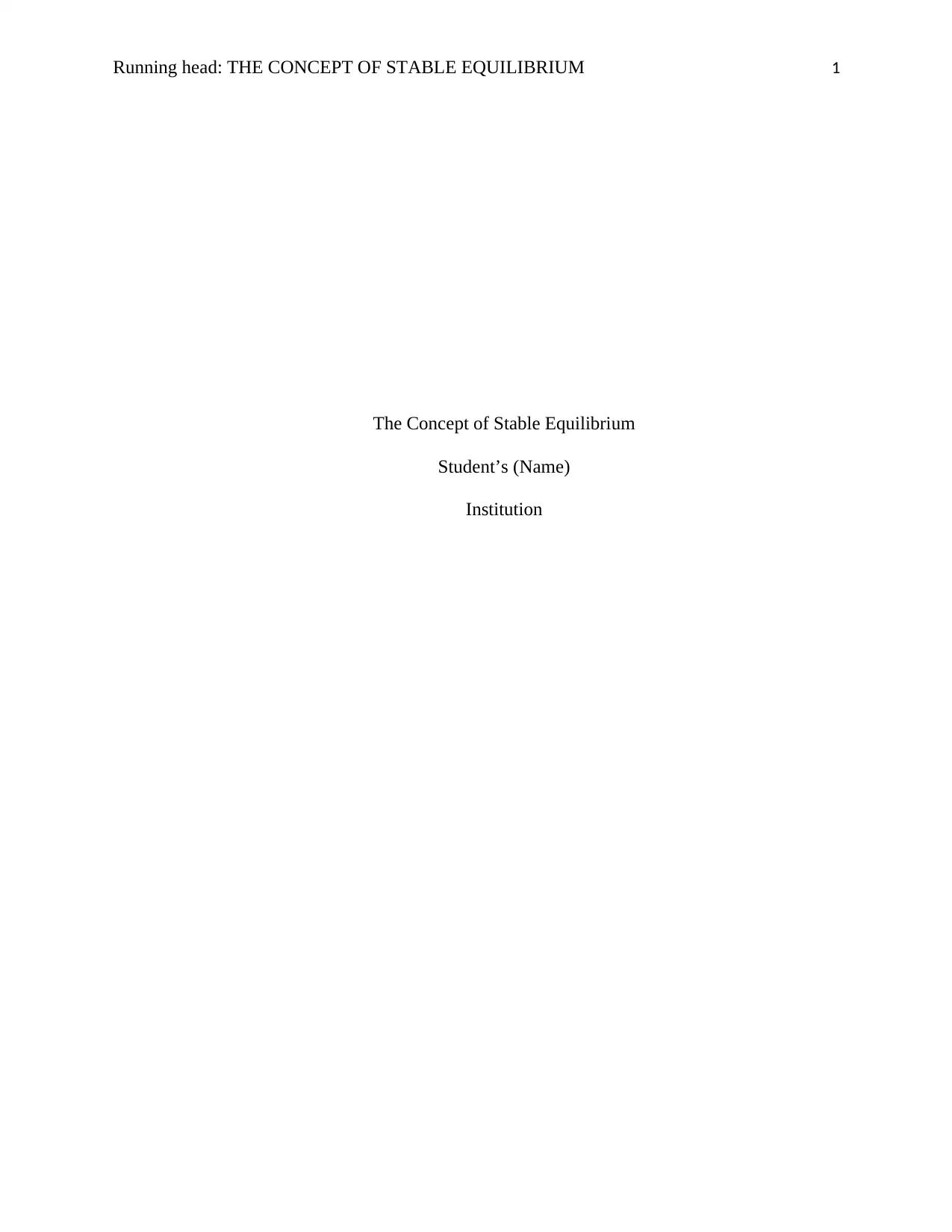
Running head: THE CONCEPT OF STABLE EQUILIBRIUM 1
The Concept of Stable Equilibrium
Student’s (Name)
Institution
The Concept of Stable Equilibrium
Student’s (Name)
Institution
Paraphrase This Document
Need a fresh take? Get an instant paraphrase of this document with our AI Paraphraser
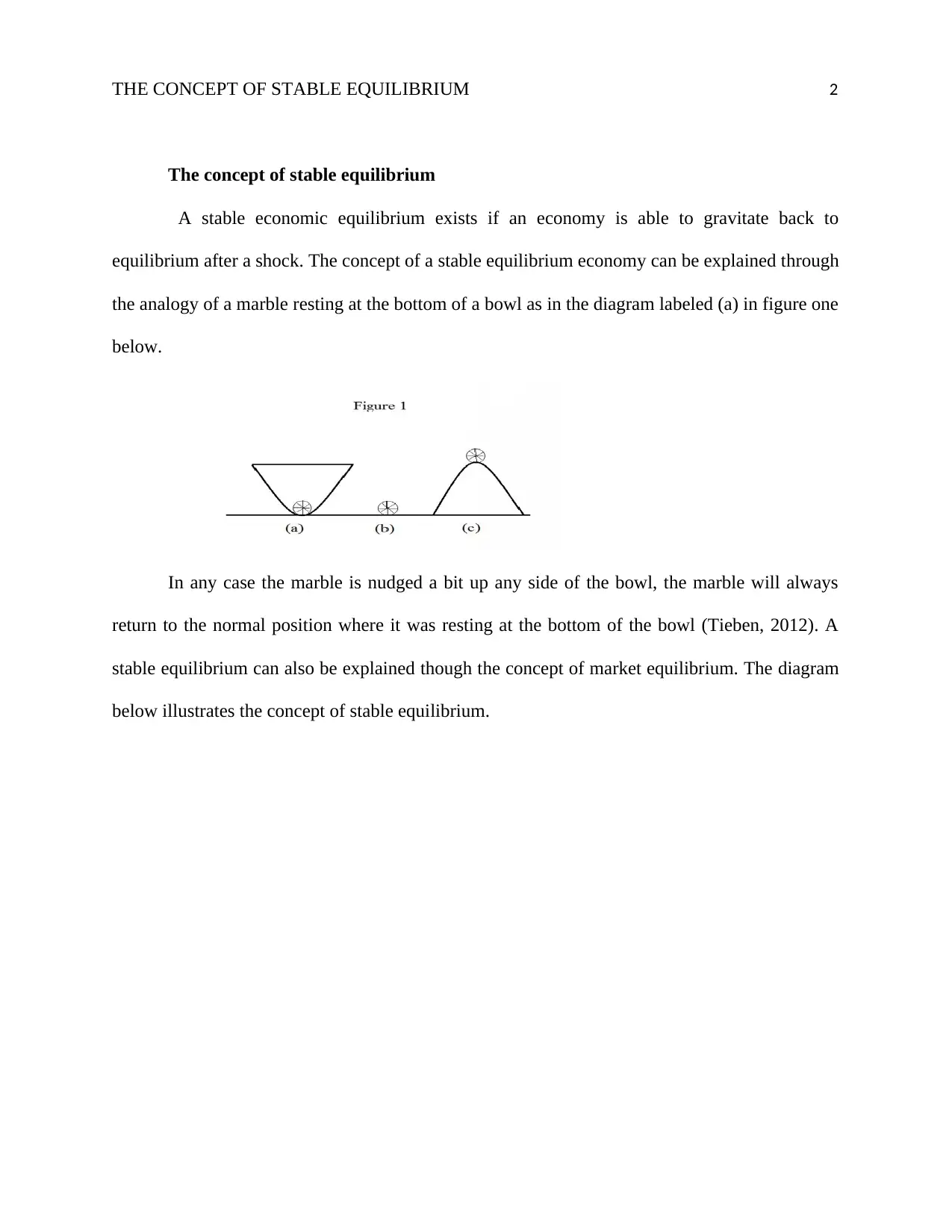
THE CONCEPT OF STABLE EQUILIBRIUM 2
The concept of stable equilibrium
A stable economic equilibrium exists if an economy is able to gravitate back to
equilibrium after a shock. The concept of a stable equilibrium economy can be explained through
the analogy of a marble resting at the bottom of a bowl as in the diagram labeled (a) in figure one
below.
In any case the marble is nudged a bit up any side of the bowl, the marble will always
return to the normal position where it was resting at the bottom of the bowl (Tieben, 2012). A
stable equilibrium can also be explained though the concept of market equilibrium. The diagram
below illustrates the concept of stable equilibrium.
The concept of stable equilibrium
A stable economic equilibrium exists if an economy is able to gravitate back to
equilibrium after a shock. The concept of a stable equilibrium economy can be explained through
the analogy of a marble resting at the bottom of a bowl as in the diagram labeled (a) in figure one
below.
In any case the marble is nudged a bit up any side of the bowl, the marble will always
return to the normal position where it was resting at the bottom of the bowl (Tieben, 2012). A
stable equilibrium can also be explained though the concept of market equilibrium. The diagram
below illustrates the concept of stable equilibrium.
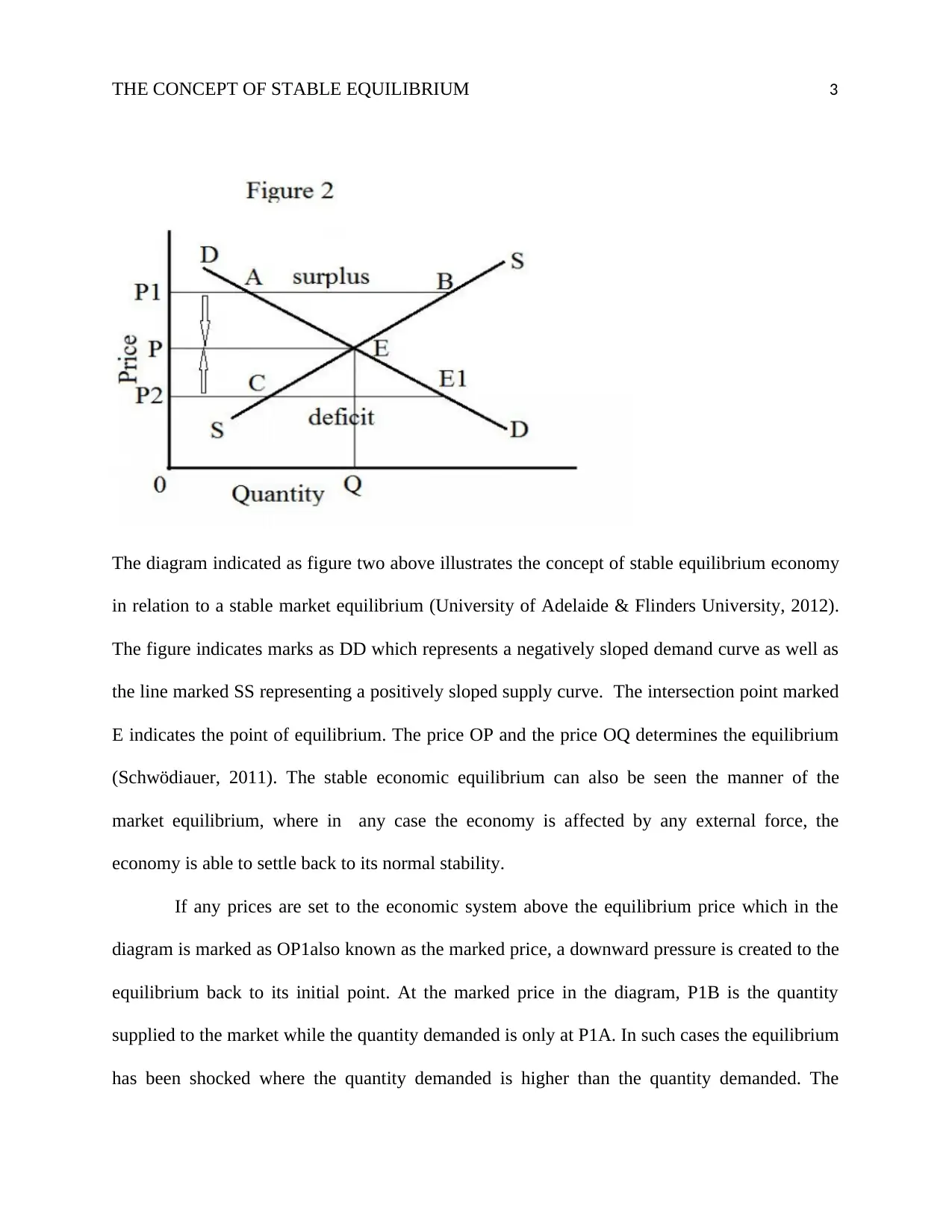
THE CONCEPT OF STABLE EQUILIBRIUM 3
The diagram indicated as figure two above illustrates the concept of stable equilibrium economy
in relation to a stable market equilibrium (University of Adelaide & Flinders University, 2012).
The figure indicates marks as DD which represents a negatively sloped demand curve as well as
the line marked SS representing a positively sloped supply curve. The intersection point marked
E indicates the point of equilibrium. The price OP and the price OQ determines the equilibrium
(Schwödiauer, 2011). The stable economic equilibrium can also be seen the manner of the
market equilibrium, where in any case the economy is affected by any external force, the
economy is able to settle back to its normal stability.
If any prices are set to the economic system above the equilibrium price which in the
diagram is marked as OP1also known as the marked price, a downward pressure is created to the
equilibrium back to its initial point. At the marked price in the diagram, P1B is the quantity
supplied to the market while the quantity demanded is only at P1A. In such cases the equilibrium
has been shocked where the quantity demanded is higher than the quantity demanded. The
The diagram indicated as figure two above illustrates the concept of stable equilibrium economy
in relation to a stable market equilibrium (University of Adelaide & Flinders University, 2012).
The figure indicates marks as DD which represents a negatively sloped demand curve as well as
the line marked SS representing a positively sloped supply curve. The intersection point marked
E indicates the point of equilibrium. The price OP and the price OQ determines the equilibrium
(Schwödiauer, 2011). The stable economic equilibrium can also be seen the manner of the
market equilibrium, where in any case the economy is affected by any external force, the
economy is able to settle back to its normal stability.
If any prices are set to the economic system above the equilibrium price which in the
diagram is marked as OP1also known as the marked price, a downward pressure is created to the
equilibrium back to its initial point. At the marked price in the diagram, P1B is the quantity
supplied to the market while the quantity demanded is only at P1A. In such cases the equilibrium
has been shocked where the quantity demanded is higher than the quantity demanded. The
⊘ This is a preview!⊘
Do you want full access?
Subscribe today to unlock all pages.

Trusted by 1+ million students worldwide
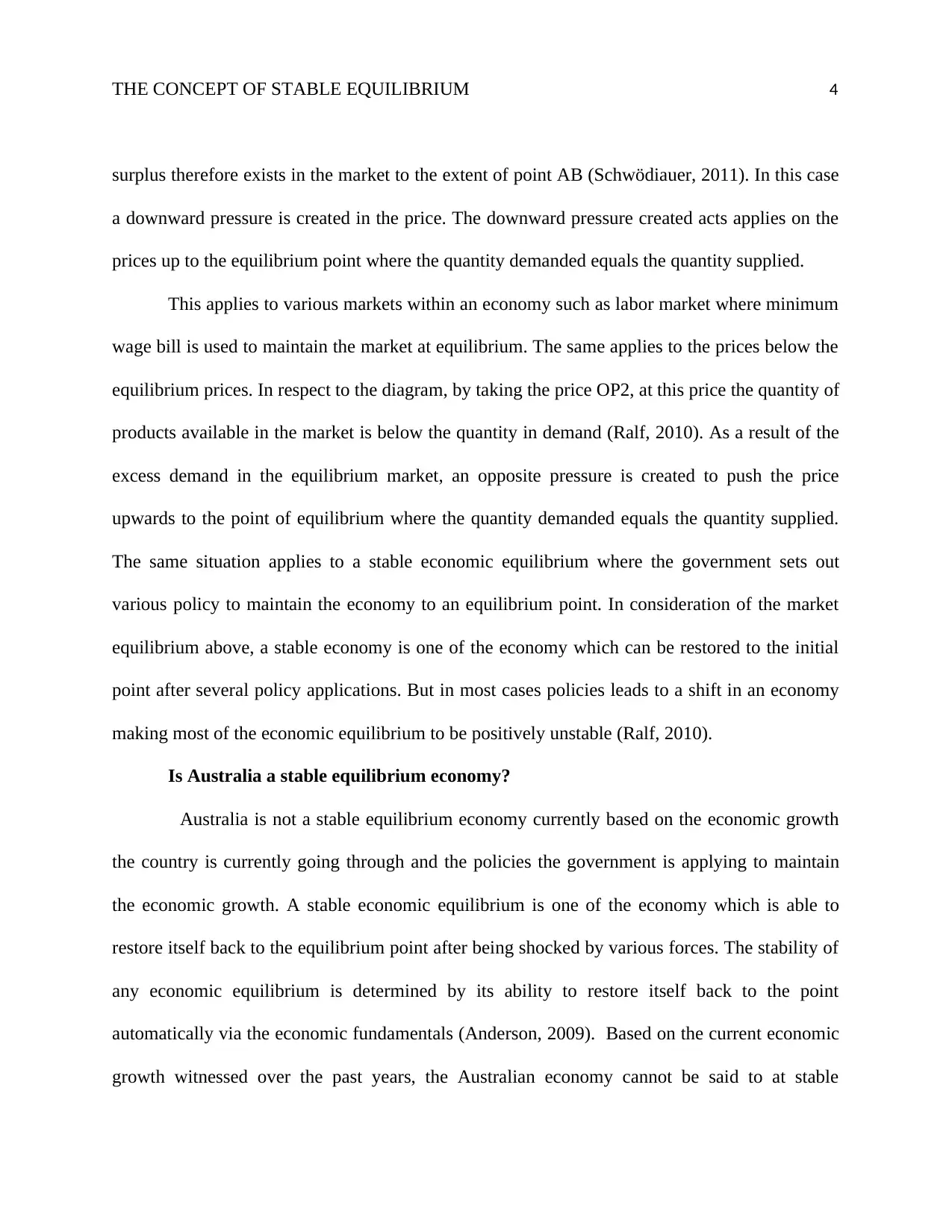
THE CONCEPT OF STABLE EQUILIBRIUM 4
surplus therefore exists in the market to the extent of point AB (Schwödiauer, 2011). In this case
a downward pressure is created in the price. The downward pressure created acts applies on the
prices up to the equilibrium point where the quantity demanded equals the quantity supplied.
This applies to various markets within an economy such as labor market where minimum
wage bill is used to maintain the market at equilibrium. The same applies to the prices below the
equilibrium prices. In respect to the diagram, by taking the price OP2, at this price the quantity of
products available in the market is below the quantity in demand (Ralf, 2010). As a result of the
excess demand in the equilibrium market, an opposite pressure is created to push the price
upwards to the point of equilibrium where the quantity demanded equals the quantity supplied.
The same situation applies to a stable economic equilibrium where the government sets out
various policy to maintain the economy to an equilibrium point. In consideration of the market
equilibrium above, a stable economy is one of the economy which can be restored to the initial
point after several policy applications. But in most cases policies leads to a shift in an economy
making most of the economic equilibrium to be positively unstable (Ralf, 2010).
Is Australia a stable equilibrium economy?
Australia is not a stable equilibrium economy currently based on the economic growth
the country is currently going through and the policies the government is applying to maintain
the economic growth. A stable economic equilibrium is one of the economy which is able to
restore itself back to the equilibrium point after being shocked by various forces. The stability of
any economic equilibrium is determined by its ability to restore itself back to the point
automatically via the economic fundamentals (Anderson, 2009). Based on the current economic
growth witnessed over the past years, the Australian economy cannot be said to at stable
surplus therefore exists in the market to the extent of point AB (Schwödiauer, 2011). In this case
a downward pressure is created in the price. The downward pressure created acts applies on the
prices up to the equilibrium point where the quantity demanded equals the quantity supplied.
This applies to various markets within an economy such as labor market where minimum
wage bill is used to maintain the market at equilibrium. The same applies to the prices below the
equilibrium prices. In respect to the diagram, by taking the price OP2, at this price the quantity of
products available in the market is below the quantity in demand (Ralf, 2010). As a result of the
excess demand in the equilibrium market, an opposite pressure is created to push the price
upwards to the point of equilibrium where the quantity demanded equals the quantity supplied.
The same situation applies to a stable economic equilibrium where the government sets out
various policy to maintain the economy to an equilibrium point. In consideration of the market
equilibrium above, a stable economy is one of the economy which can be restored to the initial
point after several policy applications. But in most cases policies leads to a shift in an economy
making most of the economic equilibrium to be positively unstable (Ralf, 2010).
Is Australia a stable equilibrium economy?
Australia is not a stable equilibrium economy currently based on the economic growth
the country is currently going through and the policies the government is applying to maintain
the economic growth. A stable economic equilibrium is one of the economy which is able to
restore itself back to the equilibrium point after being shocked by various forces. The stability of
any economic equilibrium is determined by its ability to restore itself back to the point
automatically via the economic fundamentals (Anderson, 2009). Based on the current economic
growth witnessed over the past years, the Australian economy cannot be said to at stable
Paraphrase This Document
Need a fresh take? Get an instant paraphrase of this document with our AI Paraphraser
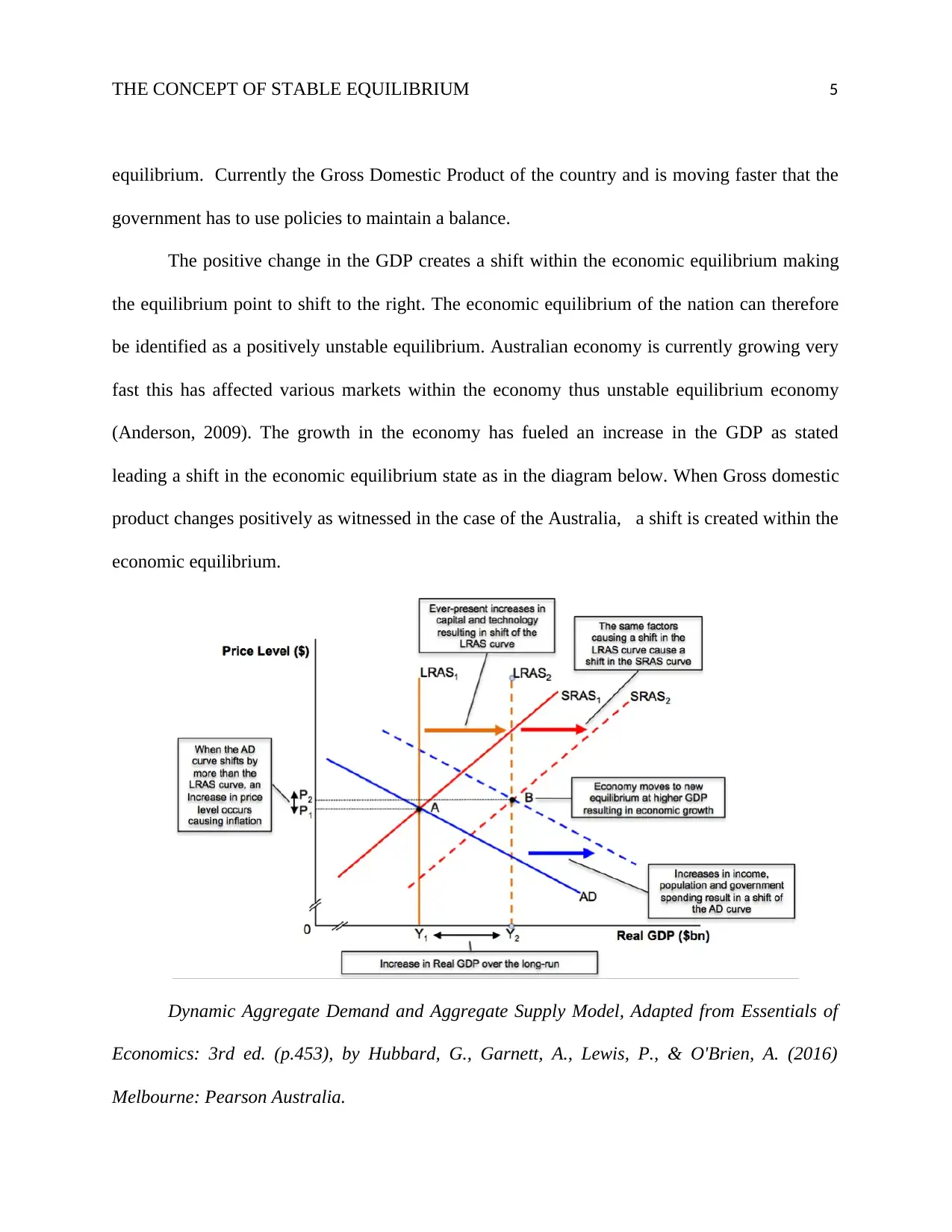
THE CONCEPT OF STABLE EQUILIBRIUM 5
equilibrium. Currently the Gross Domestic Product of the country and is moving faster that the
government has to use policies to maintain a balance.
The positive change in the GDP creates a shift within the economic equilibrium making
the equilibrium point to shift to the right. The economic equilibrium of the nation can therefore
be identified as a positively unstable equilibrium. Australian economy is currently growing very
fast this has affected various markets within the economy thus unstable equilibrium economy
(Anderson, 2009). The growth in the economy has fueled an increase in the GDP as stated
leading a shift in the economic equilibrium state as in the diagram below. When Gross domestic
product changes positively as witnessed in the case of the Australia, a shift is created within the
economic equilibrium.
Dynamic Aggregate Demand and Aggregate Supply Model, Adapted from Essentials of
Economics: 3rd ed. (p.453), by Hubbard, G., Garnett, A., Lewis, P., & O'Brien, A. (2016)
Melbourne: Pearson Australia.
equilibrium. Currently the Gross Domestic Product of the country and is moving faster that the
government has to use policies to maintain a balance.
The positive change in the GDP creates a shift within the economic equilibrium making
the equilibrium point to shift to the right. The economic equilibrium of the nation can therefore
be identified as a positively unstable equilibrium. Australian economy is currently growing very
fast this has affected various markets within the economy thus unstable equilibrium economy
(Anderson, 2009). The growth in the economy has fueled an increase in the GDP as stated
leading a shift in the economic equilibrium state as in the diagram below. When Gross domestic
product changes positively as witnessed in the case of the Australia, a shift is created within the
economic equilibrium.
Dynamic Aggregate Demand and Aggregate Supply Model, Adapted from Essentials of
Economics: 3rd ed. (p.453), by Hubbard, G., Garnett, A., Lewis, P., & O'Brien, A. (2016)
Melbourne: Pearson Australia.
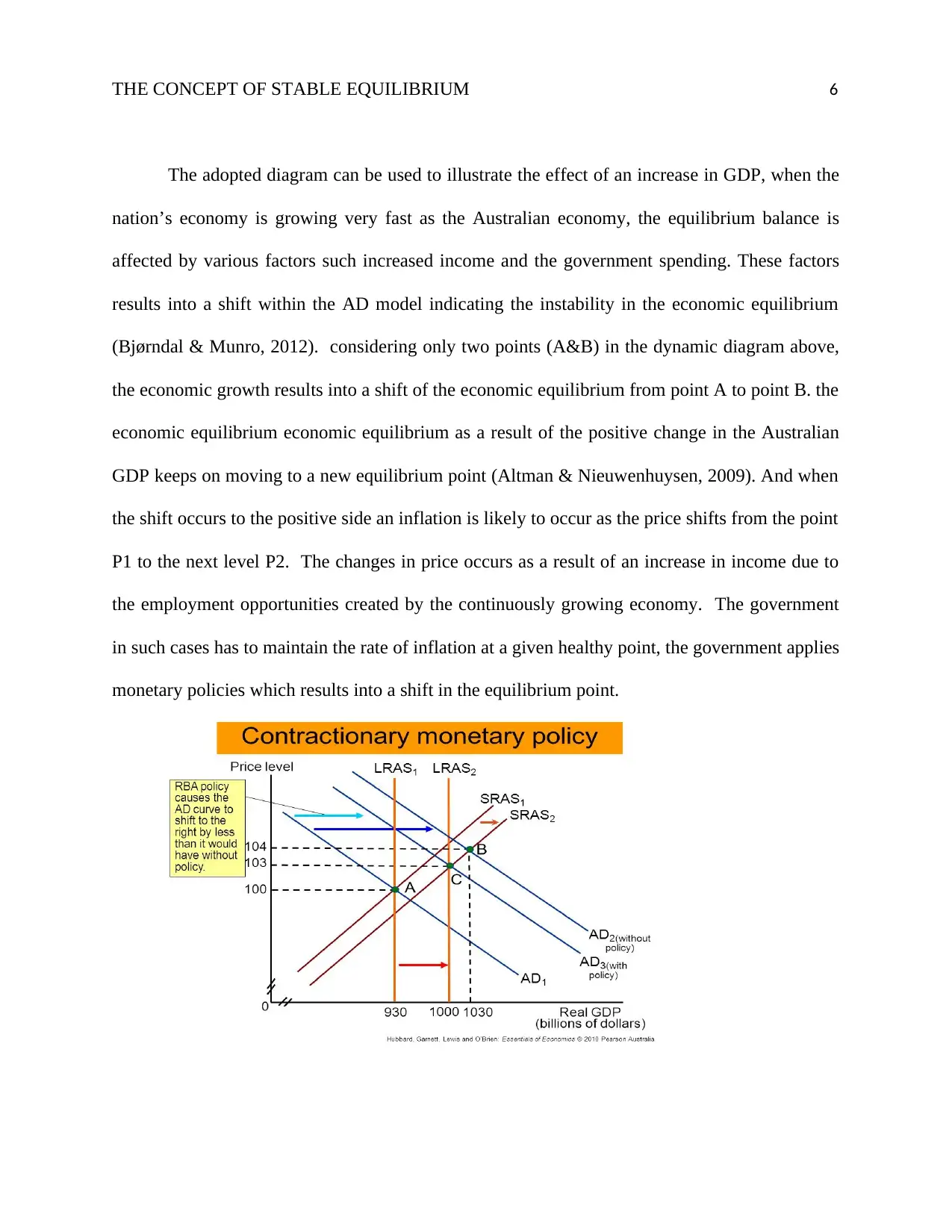
THE CONCEPT OF STABLE EQUILIBRIUM 6
The adopted diagram can be used to illustrate the effect of an increase in GDP, when the
nation’s economy is growing very fast as the Australian economy, the equilibrium balance is
affected by various factors such increased income and the government spending. These factors
results into a shift within the AD model indicating the instability in the economic equilibrium
(Bjørndal & Munro, 2012). considering only two points (A&B) in the dynamic diagram above,
the economic growth results into a shift of the economic equilibrium from point A to point B. the
economic equilibrium economic equilibrium as a result of the positive change in the Australian
GDP keeps on moving to a new equilibrium point (Altman & Nieuwenhuysen, 2009). And when
the shift occurs to the positive side an inflation is likely to occur as the price shifts from the point
P1 to the next level P2. The changes in price occurs as a result of an increase in income due to
the employment opportunities created by the continuously growing economy. The government
in such cases has to maintain the rate of inflation at a given healthy point, the government applies
monetary policies which results into a shift in the equilibrium point.
The adopted diagram can be used to illustrate the effect of an increase in GDP, when the
nation’s economy is growing very fast as the Australian economy, the equilibrium balance is
affected by various factors such increased income and the government spending. These factors
results into a shift within the AD model indicating the instability in the economic equilibrium
(Bjørndal & Munro, 2012). considering only two points (A&B) in the dynamic diagram above,
the economic growth results into a shift of the economic equilibrium from point A to point B. the
economic equilibrium economic equilibrium as a result of the positive change in the Australian
GDP keeps on moving to a new equilibrium point (Altman & Nieuwenhuysen, 2009). And when
the shift occurs to the positive side an inflation is likely to occur as the price shifts from the point
P1 to the next level P2. The changes in price occurs as a result of an increase in income due to
the employment opportunities created by the continuously growing economy. The government
in such cases has to maintain the rate of inflation at a given healthy point, the government applies
monetary policies which results into a shift in the equilibrium point.
⊘ This is a preview!⊘
Do you want full access?
Subscribe today to unlock all pages.

Trusted by 1+ million students worldwide
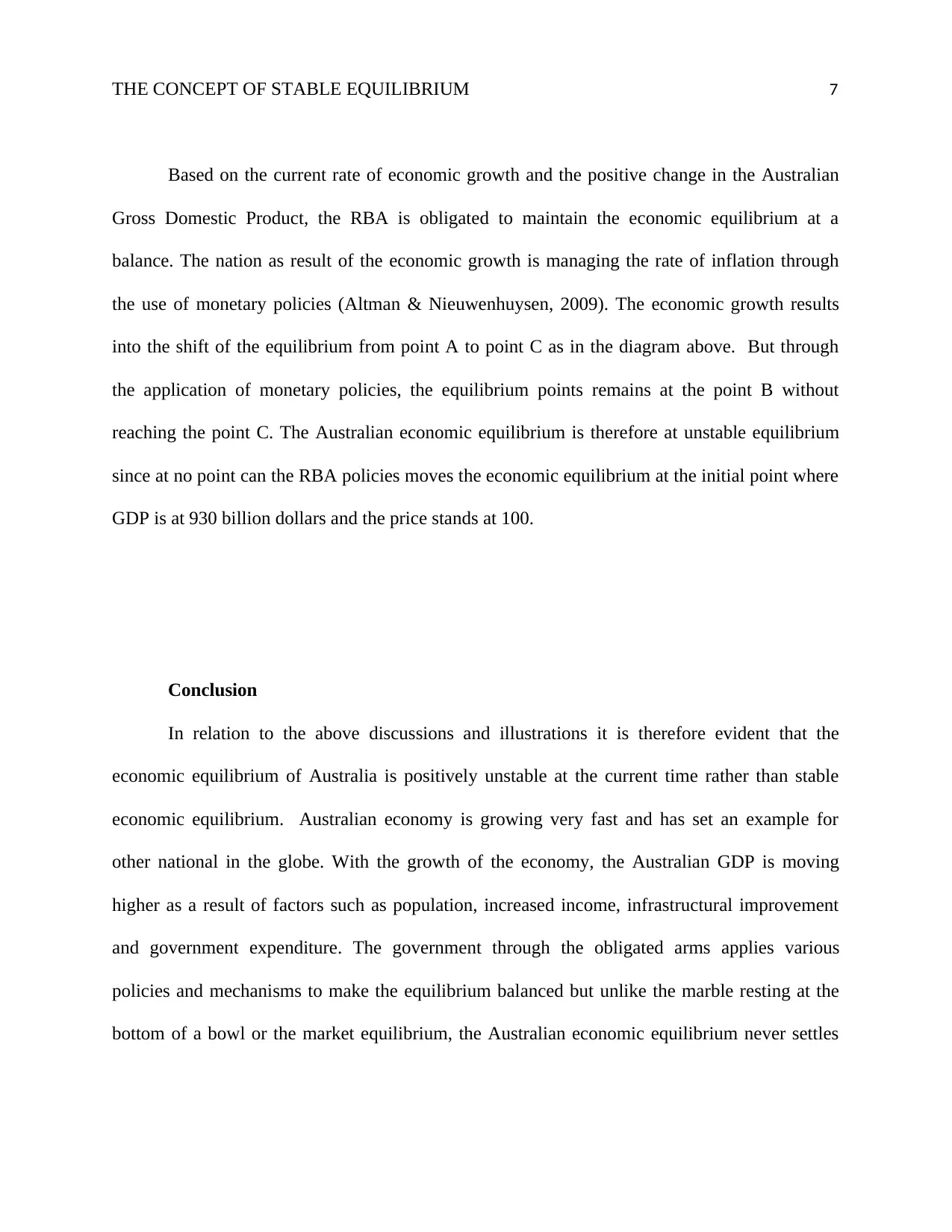
THE CONCEPT OF STABLE EQUILIBRIUM 7
Based on the current rate of economic growth and the positive change in the Australian
Gross Domestic Product, the RBA is obligated to maintain the economic equilibrium at a
balance. The nation as result of the economic growth is managing the rate of inflation through
the use of monetary policies (Altman & Nieuwenhuysen, 2009). The economic growth results
into the shift of the equilibrium from point A to point C as in the diagram above. But through
the application of monetary policies, the equilibrium points remains at the point B without
reaching the point C. The Australian economic equilibrium is therefore at unstable equilibrium
since at no point can the RBA policies moves the economic equilibrium at the initial point where
GDP is at 930 billion dollars and the price stands at 100.
Conclusion
In relation to the above discussions and illustrations it is therefore evident that the
economic equilibrium of Australia is positively unstable at the current time rather than stable
economic equilibrium. Australian economy is growing very fast and has set an example for
other national in the globe. With the growth of the economy, the Australian GDP is moving
higher as a result of factors such as population, increased income, infrastructural improvement
and government expenditure. The government through the obligated arms applies various
policies and mechanisms to make the equilibrium balanced but unlike the marble resting at the
bottom of a bowl or the market equilibrium, the Australian economic equilibrium never settles
Based on the current rate of economic growth and the positive change in the Australian
Gross Domestic Product, the RBA is obligated to maintain the economic equilibrium at a
balance. The nation as result of the economic growth is managing the rate of inflation through
the use of monetary policies (Altman & Nieuwenhuysen, 2009). The economic growth results
into the shift of the equilibrium from point A to point C as in the diagram above. But through
the application of monetary policies, the equilibrium points remains at the point B without
reaching the point C. The Australian economic equilibrium is therefore at unstable equilibrium
since at no point can the RBA policies moves the economic equilibrium at the initial point where
GDP is at 930 billion dollars and the price stands at 100.
Conclusion
In relation to the above discussions and illustrations it is therefore evident that the
economic equilibrium of Australia is positively unstable at the current time rather than stable
economic equilibrium. Australian economy is growing very fast and has set an example for
other national in the globe. With the growth of the economy, the Australian GDP is moving
higher as a result of factors such as population, increased income, infrastructural improvement
and government expenditure. The government through the obligated arms applies various
policies and mechanisms to make the equilibrium balanced but unlike the marble resting at the
bottom of a bowl or the market equilibrium, the Australian economic equilibrium never settles
Paraphrase This Document
Need a fresh take? Get an instant paraphrase of this document with our AI Paraphraser
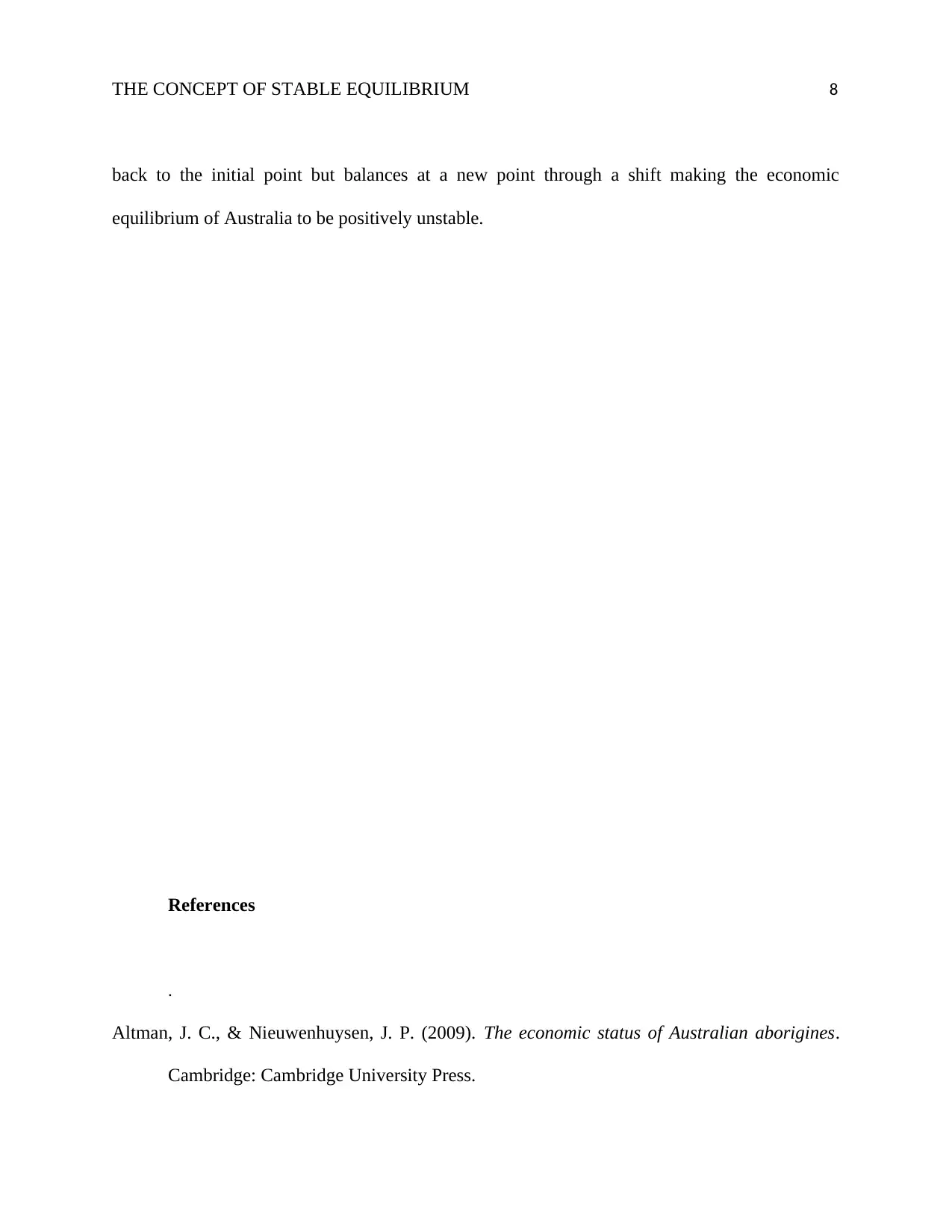
THE CONCEPT OF STABLE EQUILIBRIUM 8
back to the initial point but balances at a new point through a shift making the economic
equilibrium of Australia to be positively unstable.
References
.
Altman, J. C., & Nieuwenhuysen, J. P. (2009). The economic status of Australian aborigines.
Cambridge: Cambridge University Press.
back to the initial point but balances at a new point through a shift making the economic
equilibrium of Australia to be positively unstable.
References
.
Altman, J. C., & Nieuwenhuysen, J. P. (2009). The economic status of Australian aborigines.
Cambridge: Cambridge University Press.
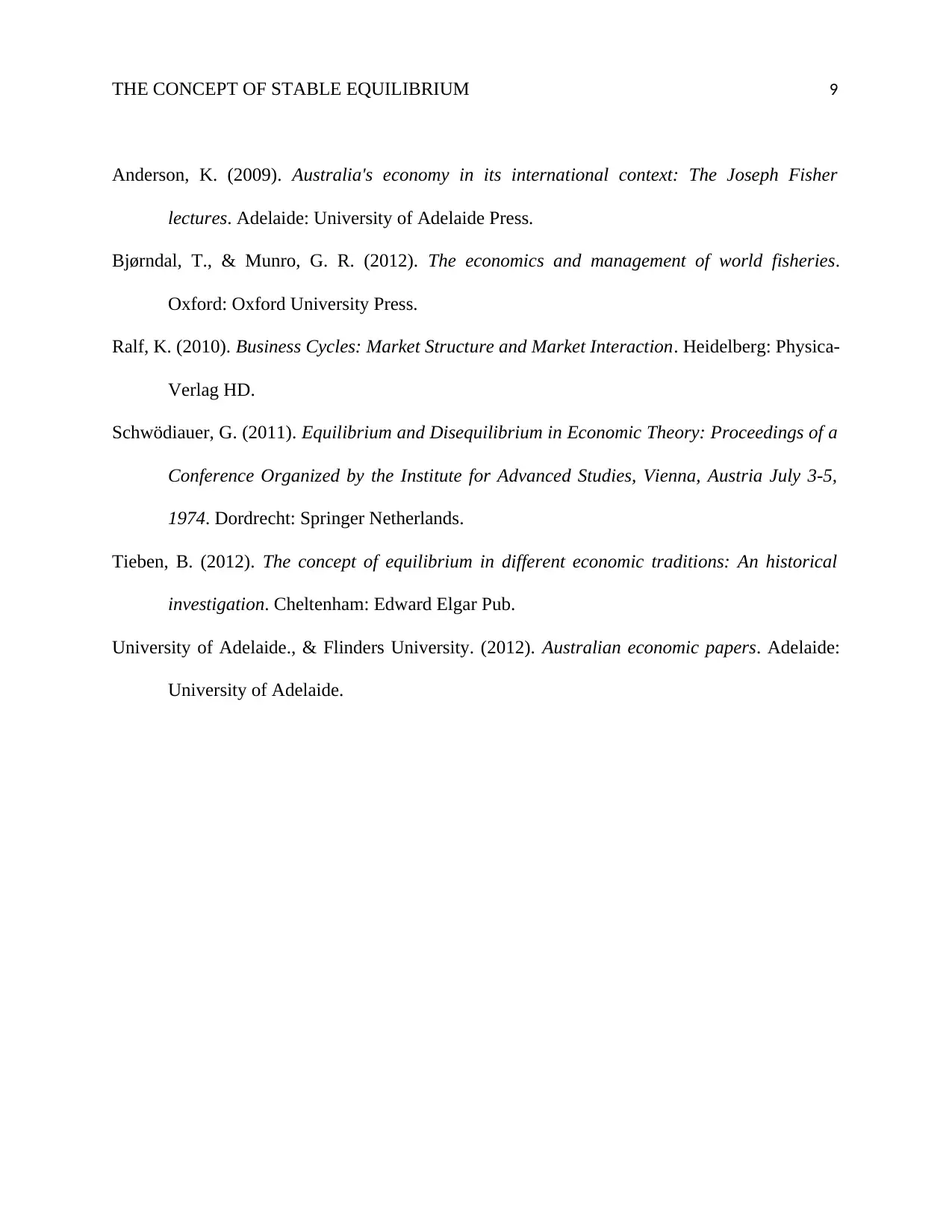
THE CONCEPT OF STABLE EQUILIBRIUM 9
Anderson, K. (2009). Australia's economy in its international context: The Joseph Fisher
lectures. Adelaide: University of Adelaide Press.
Bjørndal, T., & Munro, G. R. (2012). The economics and management of world fisheries.
Oxford: Oxford University Press.
Ralf, K. (2010). Business Cycles: Market Structure and Market Interaction. Heidelberg: Physica-
Verlag HD.
Schwödiauer, G. (2011). Equilibrium and Disequilibrium in Economic Theory: Proceedings of a
Conference Organized by the Institute for Advanced Studies, Vienna, Austria July 3-5,
1974. Dordrecht: Springer Netherlands.
Tieben, B. (2012). The concept of equilibrium in different economic traditions: An historical
investigation. Cheltenham: Edward Elgar Pub.
University of Adelaide., & Flinders University. (2012). Australian economic papers. Adelaide:
University of Adelaide.
Anderson, K. (2009). Australia's economy in its international context: The Joseph Fisher
lectures. Adelaide: University of Adelaide Press.
Bjørndal, T., & Munro, G. R. (2012). The economics and management of world fisheries.
Oxford: Oxford University Press.
Ralf, K. (2010). Business Cycles: Market Structure and Market Interaction. Heidelberg: Physica-
Verlag HD.
Schwödiauer, G. (2011). Equilibrium and Disequilibrium in Economic Theory: Proceedings of a
Conference Organized by the Institute for Advanced Studies, Vienna, Austria July 3-5,
1974. Dordrecht: Springer Netherlands.
Tieben, B. (2012). The concept of equilibrium in different economic traditions: An historical
investigation. Cheltenham: Edward Elgar Pub.
University of Adelaide., & Flinders University. (2012). Australian economic papers. Adelaide:
University of Adelaide.
⊘ This is a preview!⊘
Do you want full access?
Subscribe today to unlock all pages.

Trusted by 1+ million students worldwide
1 out of 9
Related Documents
Your All-in-One AI-Powered Toolkit for Academic Success.
+13062052269
info@desklib.com
Available 24*7 on WhatsApp / Email
![[object Object]](/_next/static/media/star-bottom.7253800d.svg)
Unlock your academic potential
Copyright © 2020–2025 A2Z Services. All Rights Reserved. Developed and managed by ZUCOL.





